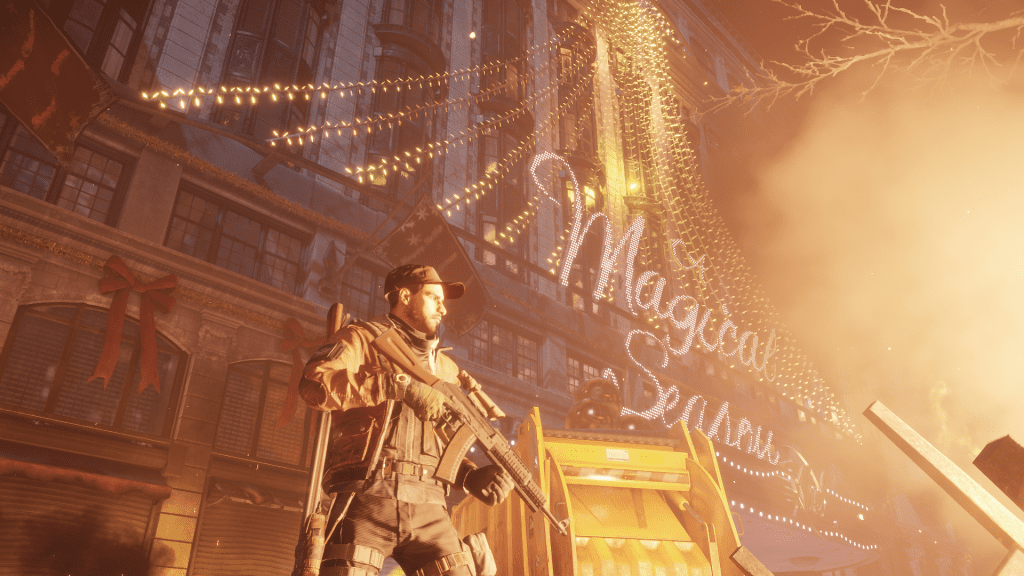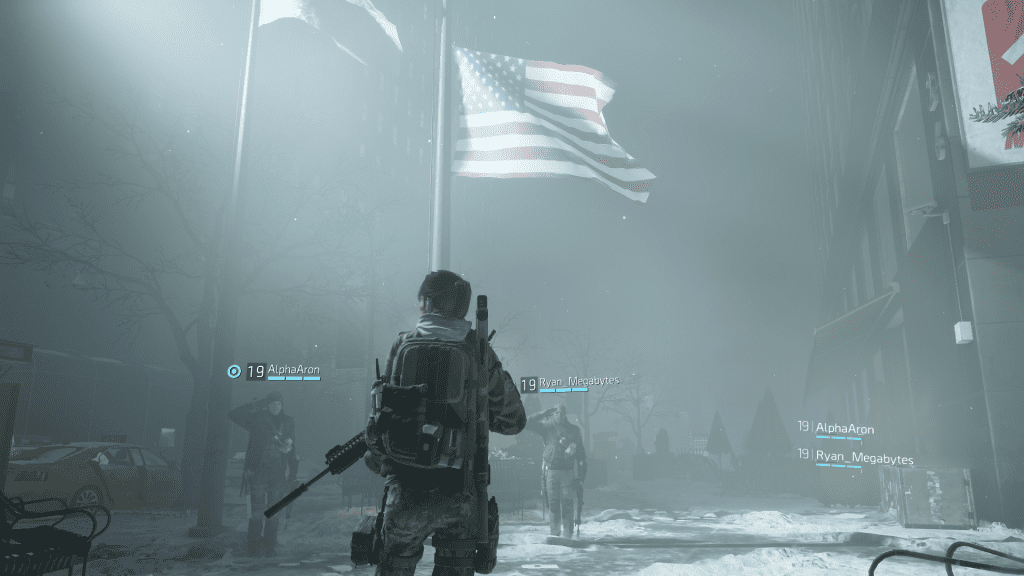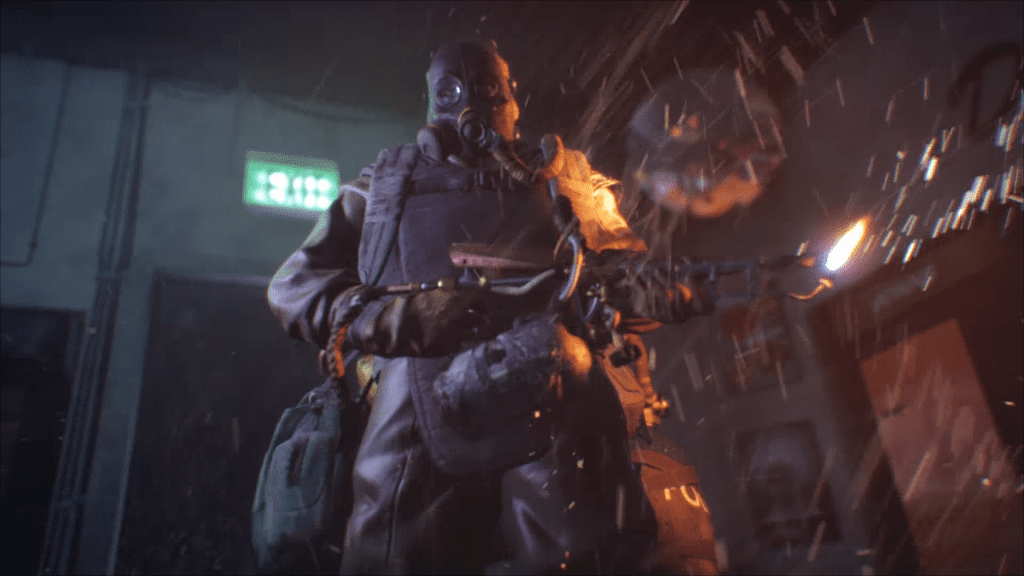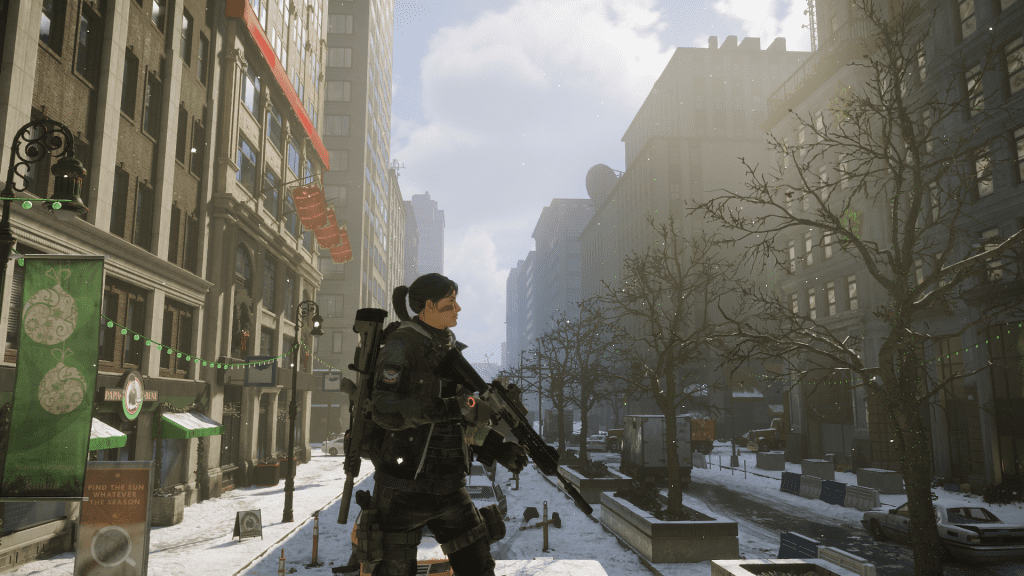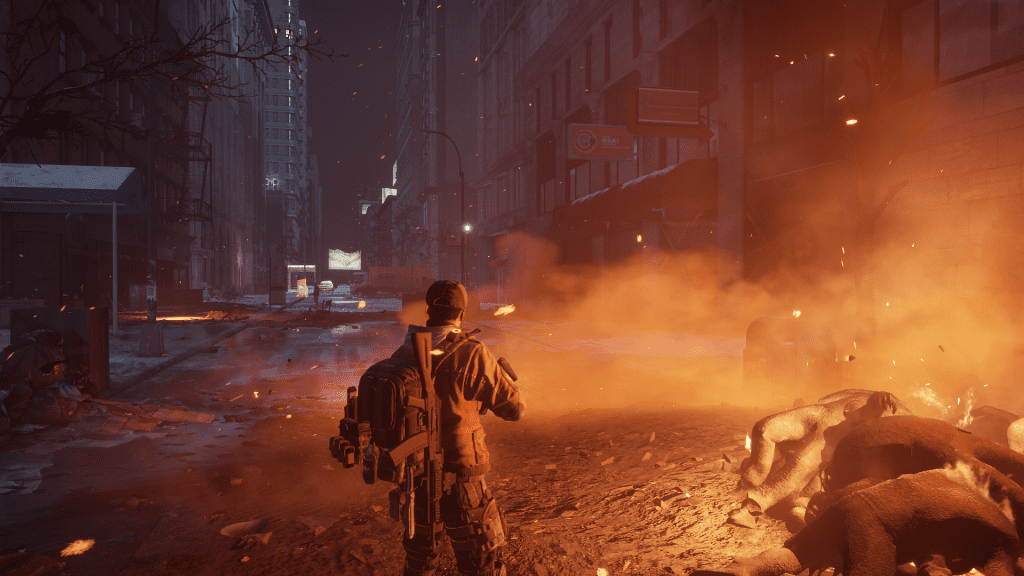Cover Image Credits: Berduu
Tom Clancy’s The Division isn’t a game wracked by a need to ply a realistic justification to its premise. An err of implausibility runs deep and flows freely at its heart, with the makeup of the game structured as such that, beyond the simplistic overtones, exists something much more substantial. And as for the base aspects of the initial Division experience, there isn’t exactly a shortage of things to single out. In the wake of the poisonous death of America’s cultural heart, the streets now belong to the warring factions of regimented pickpockets, jumpsuit-clad jailbirds and sanitation workers. Its protagonists are badly imagined caricatures that unravel quickly against a backdrop of absurdity, rarely offering little more than a colourful regaling of pre-infection New York or a sputtering of hackneyed dialogue. And its plot is propelled by the sparse fantasy of an uprising against a very clearly outlined evil, and your integral part in the necessary purification of a damned city.
The Division then is a game free of the shackles of stringent believability. It’s plainly devoid of the subtlety atypical of much Clancy fiction, but its lack of a textual derivative isn’t damning. The Division is not a true story-driven experience. It’s part role-playing game, part massively-multiplayer game and part cover-based shooter. It’s hybrid of modernised genres and an amalgamation of themes. Adapting any theoretical novel and attempting to parallel it with such an indistinct swathe of genres would’ve only succeeded in butchering the source material. No, The Division had to be original, and most importantly, the lore and narrative had to be cohesive with the template at hand.
It can be a lot to take in initially. Gone are the roving packs of people and plethora of voices that slowly rise to the fore upon every Manhattan dawn. New York’s new found quietness is rather haunting. Lone voices are now completely distinguishable along cacophonous city streets, reverberating against the slumbering towers that overlook them and beyond the broken bridges that entrap them. A woman yells in the distance as a feral mutt corners her against a blockade. Gunshots ring out nearby as hooded figures cut down a passer-by in cold blood. A low, guttural churning emits from the second-old corpse of a civilian keeled over beside you. If the protagonists of The Division seem far too colourful and cliched, then the city itself most certainly is not.
THE DARK ZONE REVELS IN CHAOS & COMPETITIVENESS, BLENDING TOGETHER COOPERATION & EMERGENT PVP IN A LAWLESS WILD WEST
The attention to detail paid to New York and its many boroughs is staggering. The Division is a marvelously good-looking game, beautiful in its realisation of a major city slumped to its knees and remarkable in its aesthetic fidelity. Every different street has its own problems to deal with and its own story to tell in the wake of the infection. Some are home to mountainous piles of garbage bags and laden with snow-covered corpses. Others are almost entirely submerged beneath the covers of citrine tarpaulin and populated solely by fire-spewing drones. And more unnerving still is that other neighbourhoods even seem relatively untouched, the abundance of vehicles strewn across the road being the only anomaly next to the softly lit street-lamps that accentuate the delicate snowfall. One moment you’ll find yourself under heavy fire at the foot of an alleyway, bullets tearing through your cover as rioters clamber over the dead and encroach upon your position. The next you’ll be slowly wandering through a public park at twilight, an amber glow warming you against the biting wind at your fore, the road ahead fading into the black as the blizzard reaches its peak.
This is the New York that remains, but there are plenty of indicators as to what the city was like when caught up in the pre-infection hysteria dotted throughout every district. Phone recordings will detail a snippet of conversation between two citizens with varying levels of concern as to what’s going on around them. The paranoid are already preparing to flee, the less-so are still weighing up the merits of buying a new TV come Black Friday. Drone cameras show overhead images of a city at war outlined by thermal imaging. Rioters holding up ration distributers in a desperate ploy for more food, civilians fleeing the rotten heart of the infection before it becomes permanently cordoned off. Most impressive though are ECHO beacons, devices that explode a three-dimensional scene around you, allowing you to analyse it as if you were a figure in some warped diorama. It’s ECHO’s that paint the bleakest scene of all, informative as they are in outlining the mass-psychosis of those clinging to the faintest hope of salvation, and those who seem more concerned with damnable profiteering.
Next to the treasure trove of enjoyably varied collectibles that The Division has to offer, the two-tier mission system will have you jumping from borough to borough and back again in the search for experience points, tech points and new gear. Endeavours within the PvE aspect of The Division are split between main missions and side missions, and tethered together by a steady level of progression that sees you upgrade your Base of Operations hub. Once you’ve first discovered your new home, you can then use it as a staging post to venture forth and complete missions in an order that pertains to your current level, and it won’t be long before you’ve found a perfect rhythm for doing so.
Upon entering a district, you’ll be encouraged to find its resident Safe House. When discovered, you’ll chat to the Joint Task Force officer that resides there whilst also interacting with the whiteboard at the back of the room, thus populating your regional map with a host of quests specific to this single area. Leaving the Safe House for the first time, you’ll amble over to the closest objective, followed by the next and the next until you’ve charted every street within the borough, all the while running a circuit that serves as both an introduction and a farewell to a location you’ll likely not return to. Backpack full to the brim of plundered loot, it’s now that you’ll decide which items to equip and which to part with, selling excess equipment for cash or breaking them down into crafting materials. And with that, it’s then time to head to the next adjacent district and repeat the process, your actions directly extending the reach of JTF patrols and cleansing your map of any and all mission icons. As a Division agent, it isn’t all investigation and conspiracy. The bigger picture looms evermore, but still at risk are many innocents trapped within the borders of the city. It’s your job to help them, and through a linear progression system that will take you all the way from Hudson Bay to Midtown, developers Massive Entertainment have ensured that the growth of your character, the advancement of the story and the difficulty of the challenge ahead all parallel with one another very neatly.
You’ll likely notice a pattern to the side missions on offer before long. You have your cardio-centric ‘Uplink Repair’ encounter, your taxing ‘Eliminate the Target’ encounter, your ‘Follow the ECHO trail’ encounter. Variety isn’t found in the structure of these missions, but definitely in the locations in which they take place. Bounty missions for example, which ask you to assassinate a prominent blight on the community, vary in this very way so as to ensure that no two encounters are typically alike. The first of these missions sees your target holed up in a public garden, raining down shots on you from above. Latter examples require you to uproot a target sequestered deep within a bus depot or pave your way through a heavily fortified shipping yard. And those locations in question are generally unique to that encounter. The bus depot, now having been taken over by escaped convicts, offered a shooting gallery far different to that of the marina or the electronics store I had fought through in the hours prior. And I only ever paid a visit to the shipping yard for the express purpose of removing the threat posed by a particularly nasty group of armed thugs.
But if side missions in The Division offer little more than passive levelling and a tour of the wonderfully constructed world that surrounds you, then they are still undoubtedly worth your time. Crossing the borders into a new section of the city for the first time can be incredibly daunting. Pre-emptively aiming down your sights, you’ll notice that your target reticule bleeds red in every direction, the threat of an ambush a very real possibility. Yet after tending to the needs of the many, another walk down those same streets shows something else. Aiming down your sights once more, the reticule instead flashes green, the shadows in the distance now being that of roaming JTF patrols positioned as a direct result of your intervention. The streets still aren’t entirely safe, but they are at least a little better off than they were, a message that rings true the very essence of conflict in The Division; you are the few, they are the many.
Main missions then offer the meatiest battles that the game has to offer, taking you all the way from gilded embassy foyers to the fiery bowels of the cities underbelly. Like every other encounter you’ll face, main missions are divided into the groupings of ‘Tech’, ‘Security’ and ‘Medical’, with each being a different path to traverse in combating the problems of the city. To suffer through some terribly acted cutscenes is to be rewarded with a battle as challenging as it is satisfying, as you square off against some particularly nefarious enemy bosses and their rampantly aggressive underlings. For the best experience in this situation, you’ll want to crank the difficulty up to its highest and bring along three friends. The Division is at its best when clambering for survival alongside your fellow agents, the composition of your four individual load-outs at times being the only thing keeping you alive. And the sheer chaos of a cooperative siege isn’t to be understated, either. Perceptive enemy AI will capitalise on your slow retreat, dousing you in flames as you fumble for a status-nullifying energy bar. You’ll stumble into cover, only to be caught in the back by a rushing rifleman. And you’ll aim a revival dart at a teammate, only to miss and be left alone to fight back the swarm as your allies count down the seconds until they may reenter the fray. You’ll die, you’ll heal, you’ll kill and you’ll die again. There are many noteworthy action set-pieces that characterise main missions just as much as the environments and enemy combatants do, but little is more memorable than the successful endurance of every battle with your allies in tow. To complete a main mission is to leave interiors torn apart by bullet fire, and to have your backpack freshly overflowing with new gear. But little is more satisfying than exiting through the same doors that you originally entered, ammunition spent, heart still racing, and the melodic whirs of the mellow soundtrack returning to prominence as the falling snow begins to rest upon your shoulders once more.
The very same calming tones also accompany every stride through the main doors of your Base of Operations. Like the drip-fed collection of new gear that determines the ever increasing strength of your agent, the Base of Operations gradually improves with the assignment of points earned through the successful completion of every mission. It’s a novel way of alleviating some of the dreariness that accompanies character building by way of perk choice. Rather than outright selecting the option to carry an additional first aid kit, you’re instead improving an aspect of the medic wing itself, a choice both beneficial to your character and plainly consistent with the rebirth narrative that the story espouses. When you were first introduced to the JTF’s new home, it was an empty marble hovel devoid of both life and purpose, but to steadily restore it is to see it flourish as a societal centrepiece once more. Seeing the base grow in tandem with your character is gratifying, but the option to improve each aspect of it as and when you choose tends to give a little more freedom to your choices, particularly when focusing on a specific type of character dynamic.
And it’s your chosen character dynamic that will go on to determine exactly which loot you perceive as either useful of useless. The constant influx of new loot is the engine that keeps the carousel spinning, and in The Division, the persistent quest for the perfect piece of gear is inherently propelling. Releasing New York from its stranglehold is only tenable so as long as your current load-out is fit for purpose, with not your arrival at the levelling threshold nor your acquiring of the perfect weapon helping abate a desire for more. In the early game, a blue-level drop is something to be cherished, an idyllic sapphire amongst a field of emerald flotsam. But as your player level rises and the need for more raw power increases, not even the luxury of a purple-grade drop can halt you in your pursuit of the strongest stats presently attainable. The bottleneck of progression at this stage devolves the loot cycle somewhat, largely substituting the enjoyable fare of cracking chests and scavenging for the more turgid endeavour of focused repetition and stat re-rolling. Yet even when outrightly unpalatable, the lure of a single high-end item is enough to spend hours wading through already charted waters, the challenge that the endgame poses remaining invigorating by way of cooperative camaraderie and challenging combat. Overcoming a steeled battalion of enemy AI at your highest level is a feat, but besting your fellow agents within the walls of The Division’s player-versus-player proving grounds is an experience almost entirely different.
DISTINCT ENEMY FACTIONS ALL POSE A DIFFERENT CHALLENGE. SURVIVAL IS ONLY THE FIRST STEP IN A LAND OF SUBJUGATION & MURDER
The Dark Zone is a hallowed field of death and desertion typified by the existence of moments of cooperation within a vacuum of betrayal. Populating the streets are some of the toughest enemy targets that the game puts in front of you, but more unnerving is the lurking of fellow Division players in the shadows that cling to every lane and alleyway. Notably appealing for its more rarified loot, The Dark Zone invites players to team up and plunder its depths at the risk of being killed during moments of weakness by other agents. Retrieving loot from the Dark Zone is only possible through helicopter extraction, a process that requires the summoning of a chopper that takes ninety seconds to arrive, and the presence of which is denoted by the firing of a clearly noticeable flare. Many fellow agents will see this as a chance to extract some of their items under the cover of allies looking to do the same, but others see it as a chance to line their coffers with ill-gotten gains. It’s why the Dark Zone is such an unique player-versus-player concept, leaning as it does on psychology and chaos theory. On the surface of it, the Dark Zone is just an extension of the main game, offering seasoned four-man teams the chance to ply their trade in an environment far more difficult than they would otherwise be used to. But beyond that, the Dark Zone measures the risk versus the reward of killing fellow players, weighing the prize of extra loot versus the offset of possibly being hunted until death by every other player on the server. You know the level of all anonymous agents, but not their strength statistics. You know what weapons their using, but not how powerful they are. You know they’ve got a pack full of loot, but not exactly how rare that loot is. The Dark Zone may be sewn onto the fabric of The Division like a band patch onto a school blazer, but its inclusion remains justifiably brilliant. So different is the tone from the main game that the Dark Zone is very worthy of its moniker, but it’s the innovative spin on the core concepts of The Division that truly make it stand out on its own.
There’s a rush to be had on both the side of the aggressor and the defender, yet it’s the voiceless interactions with other players that perhaps best define the greater impact of the Dark Zone. You’ll fire off a flare to signal another helicopter, only to be joined by an agent looking to cash-out his new rifle. The chopper arrives, the rope drops, you both attach your packages and slowly back away. He fires off a salute in your direction, you return it, and then you both head off in opposite directions back into the black loam of the city beyond. You hear the sound of gunfire erupt from your flank as another agent reaches Rogue status. You instinctively run straight back into the fray, the Dark Zone welcoming the eruption of another agent purge just as much as it had the tentative cooperation only moments earlier.
In being built upon a foundation of cyclical shooting, equipping and reequipping, The Division is very forthcoming in exactly what awaits you as you progress through its story. You’ll likely be more interested in the honing of your character as opposed to the ongoing plight around you, and that’s understandable, because the nature of The Division’s core experience dictates that everything beyond the looting prospect will wash away eventually. The Division’s biggest success is its structural soundness, however. It bares many of the impediments of several of its contemporaries, but masks them beneath a world so wonderfully authentic and a shooting mechanic so perfectly executed that it’s hard not to appreciate the game for exactly what it is. Although there will come a time when the level cap becomes impassable and your statistics just won’t budge any further, the journey up until that point is nothing short of a remarkably fun cooperative experience steeped in a richness the likes of which this hybrid genre has yet to see.
